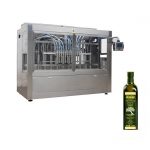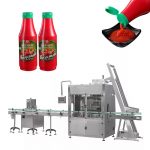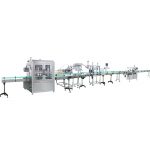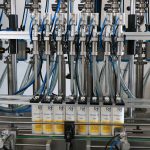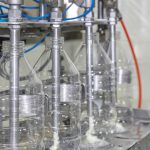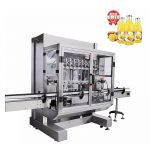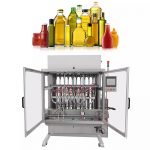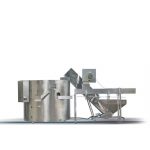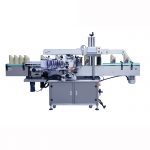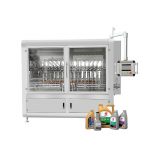What is wine filling machine?
A wine filling machine is a piece of equipment used in the wine production process to fill wine bottles with a precise volume of wine. These machines are typically used in wineries and are designed to fill bottles quickly and accurately, with minimal waste and spillage. There are several different types of wine filling machines available, including gravity fillers, vacuum fillers, and pressure fillers. Some wine filling machines are also equipped with additional features, such as cap tightening and labeling capabilities.
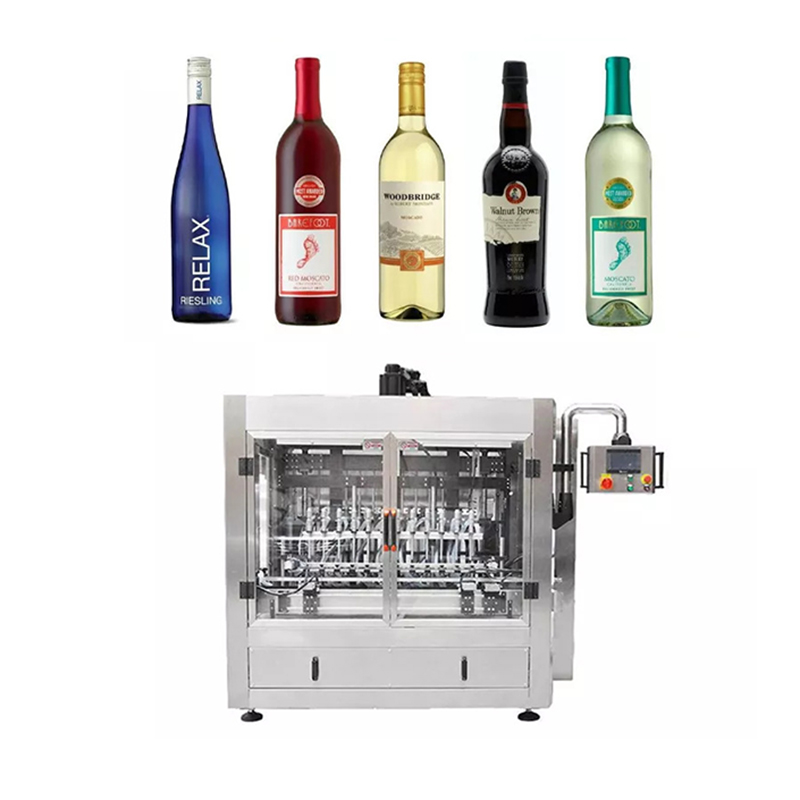
What are the different types of wine filling machines available?
There are several different types of wine filling machines available, including:
- Gravity fillers: Gravity fillers use the weight of the wine to fill bottles. The bottles are placed on a conveyor belt and the wine is poured into the bottles from above. Gravity fillers are typically used for low viscosity liquids and are capable of filling bottles at high speeds.
- Vacuum fillers: Vacuum fillers use a vacuum to remove the air from the bottle and then fill the bottle with wine. This helps to minimize oxygen pickup and wine spoilage. Vacuum fillers are typically used for higher viscosity liquids and are capable of filling bottles with high accuracy.
- Pressure fillers: Pressure fillers use pressurized air to force the wine into the bottle. These machines are typically used for high viscosity liquids and are capable of filling bottles at high speeds.
- In-line fillers: In-line fillers are automated filling systems that fill multiple bottles at once. These machines are typically used for high volume wine production and are capable of filling bottles at very high speeds.
- Net weight fillers: Net weight fillers use a load cell to measure the weight of the wine being filled into the bottle. These machines are capable of filling bottles with high accuracy and are often used for filling expensive or high-end wines.
What are the advantages of using a wine filling machine?
There are several advantages to using a wine filling machine:
- Increased efficiency: Wine filling machines are designed to fill bottles quickly and accurately, with minimal waste and spillage. This can help to increase the efficiency of the wine production process and reduce labor costs.
- Improved accuracy: Wine filling machines are capable of filling bottles with a high degree of accuracy, which is important for maintaining consistent product quality.
- Reduced labor costs: Automated wine filling machines can reduce the need for manual labor, which can help to reduce labor costs.
- Reduced waste: Wine filling machines are designed to minimize spillage and waste, which can help to reduce overall production costs.
- Increased production capacity: Wine filling machines are capable of filling bottles at high speeds, which can help to increase the overall production capacity of a winery.
- Improved safety: Automated wine filling machines can reduce the risk of injuries associated with manual bottle filling, such as back injuries from lifting heavy bottles.
- Improved product consistency: Wine filling machines can help to maintain consistent product quality by filling bottles with a precise volume of wine. This is especially important for high-end or expensive wines.
How do I choose the right wine filling machine for my business?
Here are some factors to consider when choosing the right wine filling machine for your business:
- Production capacity: Consider the volume of wine that you will be producing and choose a machine that can handle your production needs.
- Bottle size and shape: Make sure that the filling machine is compatible with the size and shape of the bottles that you will be using.
- Type of wine: Different types of wine have different viscosities and may require different types of filling machines. For example, a gravity filler may be suitable for low viscosity wines, while a vacuum filler may be more suitable for higher viscosity wines.
- Budget: Determine your budget and choose a wine filling machine that fits within your price range.
- Additional features: Consider any additional features that you may need, such as cap tightening, labeling, or corking capabilities.
- Maintenance and repair: Research the maintenance and repair requirements of different wine filling machines and choose a machine that is easy to maintain and repair.
- Brand reputation: Consider the reputation of the manufacturer and choose a wine filling machine from a reputable brand.
- Customer support: Look for a wine filling machine that comes with good customer support, such as a warranty or technical assistance.
How do I maintain and clean a wine filling machine?
Proper maintenance and cleaning of a wine filling machine is important to ensure optimal performance and a long lifespan. Here are some general guidelines for maintaining and cleaning a wine filling machine:
- Follow the manufacturer's instructions: Each wine filling machine is different and may have specific instructions for maintenance and cleaning. Follow the manufacturer's instructions carefully to ensure proper maintenance and cleaning.
- Clean the machine regularly: It is important to clean the machine regularly to prevent the build-up of dirt, grime, and bacteria. Use a mild detergent and warm water to clean the machine, and be sure to rinse thoroughly.
- Check and replace worn parts: Regularly inspect the machine for any worn or damaged parts and replace them as needed. This can help to prevent breakdowns and improve the performance of the machine.
- Perform regular maintenance: Follow the manufacturer's maintenance schedule and perform regular maintenance tasks, such as lubricating moving parts and checking seals.
- Store the machine properly: When the machine is not in use, store it in a clean, dry place to prevent rust and other damage.
- Follow safety guidelines: Always follow safety guidelines when working on or cleaning the wine filling machine. This may include wearing protective gear, such as gloves and safety glasses.
- Seek professional assistance: If you are not comfortable performing maintenance or cleaning tasks on the wine filling machine, seek the assistance of a professional.
What are the safety considerations when using a wine filling machine?
There are several safety considerations to keep in mind when using a wine filling machine:
- Follow the manufacturer's instructions: Each wine filling machine is different and may have specific safety instructions. Follow the manufacturer's instructions carefully to ensure safe operation of the machine.
- Wear protective gear: When working with a wine filling machine, it is important to wear protective gear, such as gloves and safety glasses, to protect against spills and splashes.
- Use caution when handling heavy bottles: Some wine filling machines require manual handling of heavy bottles. Use caution when lifting and moving heavy bottles to avoid injuries.
- Keep the machine clean: Regularly clean the wine filling machine to prevent the build-up of dirt, grime, and bacteria, which can increase the risk of accidents and injuries.
- Use caution when working with hot liquids: If the wine filling machine is used to fill hot liquids, use caution to avoid burns.
- Use caution when working with pressurized systems: Some wine filling machines use pressurized systems to fill bottles. Use caution when working with these systems to avoid accidents and injuries.
- Follow electrical safety guidelines: If the wine filling machine is powered by electricity, follow electrical safety guidelines to avoid electrocution and other injuries.
- Follow general safety guidelines: Follow general safety guidelines when working with any machinery, such as not wearing loose clothing or jewelry and keeping the work area clear of clutter.
How much does a wine filling machine cost?
The cost of a wine filling machine can vary significantly depending on the type of machine, its features, and its capacity. Here are some general price ranges for different types of wine filling machines:
Gravity fillers: Gravity fillers can range in price from a few thousand dollars for a basic manual filler to tens of thousands of dollars for a high-capacity, automated machine.
Vacuum fillers: Vacuum fillers can range in price from a few thousand dollars for a basic manual filler to tens of thousands of dollars for a high-capacity, automated machine.
Pressure fillers: Pressure fillers can range in price from a few thousand dollars for a basic manual filler to tens of thousands of dollars for a high-capacity, automated machine.
In-line fillers: In-line fillers can range in price from tens of thousands of dollars for a basic machine to hundreds of thousands of dollars for a high-capacity, automated system.
Net weight fillers: Net weight fillers can range in price from a few thousand dollars for a basic manual filler to tens of thousands of dollars for a high-capacity, automated machine.
It is important to consider the long-term cost of a wine filling machine, including maintenance and repair costs, when choosing a machine for your business. It may be worth investing in a higher-priced machine with a longer lifespan and lower maintenance costs.
Can a wine filling machine be used for other types of liquids?
Some wine filling machines can be used for filling other types of liquids, such as juices, spirits, and non-alcoholic beverages. However, it is important to consider the specific properties of the liquid being filled and choose a filling machine that is suitable for that particular liquid. For example, a wine filling machine designed for low viscosity liquids may not be suitable for filling high viscosity liquids, such as fruit juices or syrups. It is also important to ensure that the filling machine is compatible with the size and shape of the containers that you will be using. Some filling machines may be more versatile and able to fill a wider range of liquids, while others may be more specialized and designed for filling a specific type of liquid. It is always best to consult the manufacturer or a filling equipment specialist to determine the suitability of a particular filling machine for a specific liquid.
What are the different packaging options available with a wine filling machine?
Wine filling machines are typically designed to fill glass bottles, but some machines may also be able to fill other types of containers, such as bags or pouches. Here are some common packaging options available with wine filling machines:
- Glass bottles: Glass bottles are the most common packaging option for wine. Wine filling machines are designed to fill bottles quickly and accurately, with minimal waste and spillage.
- Caps and closures: Some wine filling machines are equipped with cap tightening or corking capabilities. This can help to ensure that the bottles are properly sealed and prevent leakage.
- Labels: Some wine filling machines are equipped with labeling capabilities, which can help to apply labels to the bottles quickly and accurately.
- Cases: Many wine filling machines are designed to package the filled bottles into cases or boxes for shipping and storage.
- Bags or pouches: Some wine filling machines may be able to fill bags or pouches with wine. These packaging options can be convenient for smaller quantities of wine or for on-the-go consumption.

